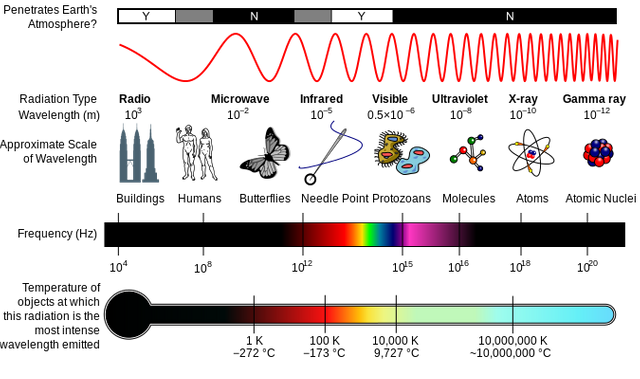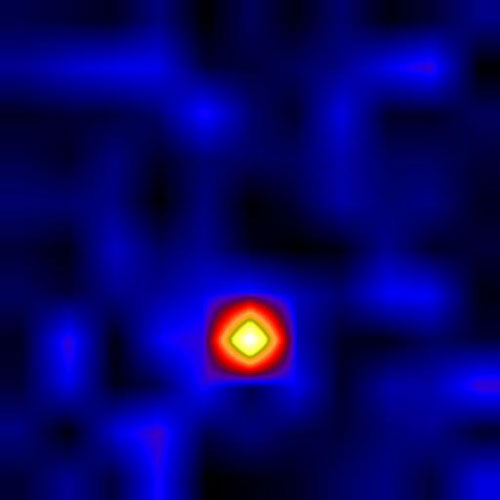Cosmic Rays and Infinity
Mysterious high-energy radiation that reaches Earth has been extensively observed, which can produce showers of secondary particles that can reach the surface of the planet. This radiation is composed primarily of high-energy protons and atomic nuclei and is known as cosmic rays.
These are considered in current models to originate from the supernova explosions of stars or be produced by active galactic nuclei.
Is this necessarily what we are observing?
Infinity
In a universe that is infinite (see my other articles here on Steemit for more information), there is no end to how large or how small systems can be. Beyond atoms, the entire electromagnetic spectrum can be viewed as the result of the relative mass of the largest building blocks of each given component. Our ability to measure and observe systems furthest from us become increasingly difficult as the relative differences increase.
As a result, we approximate all light as having "no mass" when, in reality, light has infinitesimal mass. The discrepancies in the masses of these small systems, then, can be compared indirectly in what we call the "electromagnetic spectrum."
The lower the energy, the lower the mass; the higher the energy, the higher the mass. Even E=mc2 describes this interchangeability of mass and energy.
Everything Emits
Every system in the universe emits. Stars emit largely in what we call the visible light spectrum. Planets, being less massive, emit in the infrared light spectrum. Smaller systems still emit in lower frequencies of the electromagnetic spectrum. Larger systems, such as what we call "black holes", emit in the X-ray spectrum, as seen in this X-ray image of Cygnus X-1:
Bodies do not reach some critical level where they are suddenly too massive to emit anything, but rather larger masses emit larger masses (such as X-ray spectrum light, in the example of Cygnus X-1). This is why black holes appear as singularities: because their emissions are beyond the visible light spectrum.
Mass in the universe, though, does not stop at some cut-off point, and there are ever larger masses in the infinite universe. These masses of larger "black holes" relative to atoms reach a point where their emissions are so large that we no longer call these emitted bodies "light" but instead we recognize them to be massive particles.
In the infinite universe, cosmic rays are the "light" coming from sufficiently massive "black holes" that reaches Earth and is observed as particles.
More Information
For more information, check out my other posts here on Steemit, visit my website CascadingUniverse.Org or check out my research paper, its accompanying video, and my book here.
Thanks for reading!
-Steve Scully



Really good article, everything is the same, relative and simple. It simplifies/explains many of modern science "mysteries". One such, which I think could be a good example for this article, is"black hole winds". Can this "mysterious" phenomenon be interpreted as black hole emitions which are much heavier than... light (even x-rays and gamma rays) so that we observe them as hot gas winds? Or could they be some sort of their "magnetic field" or something equivalent to solar wind? Here are some links (with some weird explainations):
http://science.nationalgeographic.com/wallpaper/science/photos/black-holes-gallery/black-hole-wind/
https://www.sciencenews.org/article/magnetism-helps-black-holes-blow-gas
https://phys.org/news/2018-01-newborns-survivors-unexpected-hostile-black.html
Hi Jim, thanks a lot! :D
In terms of black hole winds, its hard to say what precisely it would be without finding more particular information on its mechanics. I would say that it could definitely be the "radiation" of "black holes", seen as "hot gas winds" due to its detectable mass, but whether it is would depend on how consistent and uniform it is. If it basically is emitted from the entire body and relatively consistently, then it would likely be its "radiation". Or, if it is more sporadic, random and directional, it could be more like a black hole's "solar flare" equivalent, which most certainly would also occur and be something to consider in all black hole emission observations.
If it is part of the electromagnetic field would depend on if there is a Figure-8 orbit formed or if the particles were able to travel indefinitely away like light from a star. My guess is black holes at the center of galaxies still are relatively low in mass and their electromagnetic field is formed of particles that we still label as "light" (like the Fermi X-ray bubbles you mentioned before, and the microwave haze), but that is a complete guess; maybe "atoms" are components of electromagnetic fields of larger mass bodies that "soon", it's definitely possible. On a large enough scale, any system will be part of a larger system's electromagnetic field. The particulars of which bodies use which particles are a bit harder to say without more observational consideration, on observations that may or may not already have been made.
Even entire galaxies--all the galaxies that we see--are all part of one object's electromagnetic field. This concept I find particularly interesting, as everything that we see in the observable universe would be the smallest fraction of one loop of its electromagnetic field moving together. It appears we are observationally aware of this flow in what is known as "dark flow". Perhaps our Milky Way galaxy is one particle in the electromagnetic field of the Great Attractor, which would give credence to the concept that galactic center black holes are large enough to use atoms as part of their electromagnetic field rather than to emit them as radiation that escapes their gravity.
Thank you for your response. Indeed there is a big gap, in terms of mass, between radiation and atoms to interpret gas winds as "radiation", even for a black hole. Probably, as the term suggests, it is something equivalent to solar wind.
As for your comment on out galaxy as being just a particle of greater scale system, for sure I suppose that even a galaxy will either move in a circular orbit around a bigger object or in a figure-8 orbit towards an even more massive object. As we observe nearby galaxies tend towards a point, then a figure-8 orbit towards the Great Attractor is more likely. Or we could be the "atoms" of another massive object.
Two more questions a bit irrelevant to the current article if you can answer them here or in a later article:
If I am not mistaken, neutrinos are heavier particles than photons. If this is true, then why neutrinos pass through the earth, but photons don't and most of them are actually reflected?
(That's a bigger one) About the relation of a bigger object and its smaller containing particles, like earth and atoms. We can view matter as a result of a dense area of smaller "invisible" particles, so this dense area is observed as a single object. For example, earth is a big dense area of atoms and we observe it as a single object relative to its "empty" surroundings. However, atoms, on a lower scale, are also tiny regular systems (like solar systems or galaxies). How could these small solar systems orbit inside and stay around the center of mass? What could be the motion-forces-relations of these inner systems? (Note: mainstream physics says that atoms move randomly inside, however we do not see many random orbits/motion in bigger scale systems)
Thanks in advance.
So if a blackhole emits, does that kinda kill the wormhole theory?
Or is it possible that the emission that a black hole has is connected to the other side of the wormhole?
Well, black holes aren't portals to some other place in the cosmos, but they are a kind of "wormhole". Not in some unique sense, though, nor in the way that we think of wormholes; but everything is a "wormhole" in its own right. For example, the Earth pulls infinitesimal particles around it by its force of gravity which then travel physically through it and out the other side in a sort of "wormhole" kind of way. Those that come out the other side and are still stuck in its gravity are bent back inward over time and travel in a Figure-8 orbital which then arises in what we see as Earth's electromagnetic field. This is how gravity can be shown to produce electromagnetism, in general, due to the ability of smaller particles to physically pass through larger ones (such as neutrinos being known to pass through the Earth). Any electromagnetic field is the result of this type of "wormhole" for smaller particles flowing through larger particles by gravity. Again, though, it isn't the same concept of "wormhole" that we propose, where it is essentially a portal to some other location in the cosmos.
If we are small enough relative to a black hole, we could also theoretically pass through a black hole but we wouldn't come out at some other physical location in the universe, we would come out the other side of the body just the same. Even if our atoms could make the journey without physically colliding with the "atoms" of the black hole (think of it as a planet composed of what we call 'solar systems' as its 'atoms') we would still be in the extremely high temperatures and pressures that would be present which would not be pleasant.
Black hole emissions are no different than a star's emissions; they are a function of its mass. Larger masses emit larger mass systems, but they are still ultimately components of the system that are radiated outward and aren't originating from some other location in the universe (through a wormhole).
I write a bit more about black holes in other posts, such as What is a Black Hole? and The Truth About Black Holes, if you'd like to check them out. Most my interpretations largely build off of the concept that the universe is infinite and that gravity causes everything, though. The Big Bang's Big Assumption goes through many critical observations and really explains why gravity, the only fundamental force in the universe, causes them. There is a lot to it, if you are interested I have written many articles here on Steemit that go into extensive detail on it all.
Thanks for reading, commenting, and liking the article! Hope my answer made some sense and that you check out other posts of mine for more exposure to it all. :)
-Steve